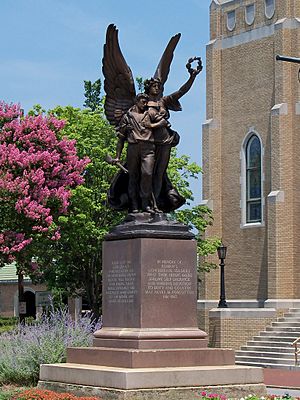Gloria Victis (Confederate monument) facts for kids

Gloria Victis, Salisbury (location from 1909 to 2020)
|
|
| Location | Salisbury, North Carolina, U.S. |
|---|---|
| Type | Confederate Monument |
| Completion date | 1891 |
| Dismantled date | 2020 |
Gloria Victis is a famous statue located in Salisbury, North Carolina. Its name means "Glory to the Defeated" or "Glory to the Conquered." It is also known by the name Fame. This statue is a Confederate monument. It was created in Brussels in 1891.
Gloria Victis is one of two very similar sculptures. Both were made by the artist Frederick Ruckstull. The other statue was the Confederate Soldiers and Sailors Monument in Baltimore. That statue was removed from public view in 2017.
Contents
Understanding the Statue
This bronze statue stands about 23 feet (7 meters) tall from the bottom of its base. It shows an angel with large, open wings. She is wearing long robes and has a laurel wreath on her head. A laurel wreath is a symbol of victory or honor.
The angel is holding a dying soldier in one arm. The soldier is holding a damaged rifle. In her other hand, held high, the angel holds another laurel wreath. This part of the statue is meant to show "glory to the defeated."
The Statue's Base
The statue rests on a pink granite base. This stone came from Balfour Quarry near Granite Quarry. On the base, there is an inscription that says "Deo Vindice." This Latin phrase means "With God as our champion" or "With God as our vindicator."
The dying soldier in the statue was modeled after a real person. He was Confederate Lt. Henry Howe Cook from Franklin, Tennessee. A photograph from 1861 was used as a guide.
The Statue's Journey and Dedication
Gloria Victis was first shown at an exhibition in Paris, France. After that, it was displayed in a studio in New York City. There, a group called the United Daughters of the Confederacy (UDC) bought it. They wanted it to be a Confederate monument for Salisbury.
It took about ten years to raise enough money for the statue. They collected $9,000 for the statue itself and $1,500 for its base.
Dedication Ceremony
The statue was officially dedicated in Salisbury on May 10, 1909. This date was Confederate Memorial Day. Many important people attended the ceremony. Anna Morrison Jackson, the widow of Confederate General Stonewall Jackson, was there. Also, 162 Confederate veterans attended the event.
During the dedication, a writer named Frances Fisher Tiernan read her poem called Gloria Victis. At that time, the statue was dedicated to 2,500 Confederate soldiers from Rowan County.
Land for the Monument
In 1927, A.H. Boyden, who was mayor in 1908, said he signed a paper. This paper, from August 1908, set aside the land for the statue at West Innes and Church Streets. The paper stated that the site would be used "perpetually for said monument."
In 1990, the UDC helped raise money to fix the statue. It had to be taken to Cincinnati for repairs.
Discussions and Relocation
In 2015, the North Carolina General Assembly passed a law. It was called the Historic Artifact Management and Patriotism Act. This law made it harder to move state-owned artworks or memorials. They could only be moved with permission from the North Carolina Historical Commission. There were exceptions for public safety or if a private owner agreed.
That same year, a tragic shooting happened at a church in Charleston. This event led to more discussions about moving the statue.
Vandalism and Public Debate
On August 18, 2018, the monument was covered in white paint. This seemed to be a response to flyers distributed in some neighborhoods. On March 20, 2019, the statue was vandalized again with yellow paint. After this second incident, people asked for a public meeting to talk about moving the statue.
Even though there was no official record of the 1908 land agreement, the city was told it did not control the land. The city council heard from many speakers in June 2019. The city attorney explained that the 2015 state law limited how monuments could be moved, unless it was for safety reasons.
A professor from Catawba College, Gary Freeze, suggested a new marker near the site. He also proposed new artwork at the statue's original spot.
The Decision to Move
More discussions about moving the statue happened after shots were fired near it during the 2020 George Floyd protests. Someone also pointed out that the statue made it harder to see traffic. Safety had been a concern in earlier years too, like 1948, 1959, and 1964.
An online petition with over 7,000 signatures asked for the statue to be moved. It said the statue seemed to support "white supremacy" and honored a government that supported slavery. On the other hand, a group called Fame Preservation Group said the statue honored those who fought "against a federal military force invading their land." They felt it was part of Salisbury's identity. Their petition against moving it had 2,600 signatures.
Possible new locations were suggested, including Salisbury Prison and Old Lutheran Cemetery. On June 16, the city council voted to move the statue. They decided this because of a threat to public safety.
On June 21, the UDC signed an agreement. The statue would be moved to Old Lutheran Cemetery, where Confederate soldiers are buried. This location was discussed with families of those who helped raise money for the statue.
The statue was moved on July 7, 2020. It will eventually be placed in its new, prepared location.
Images for kids




